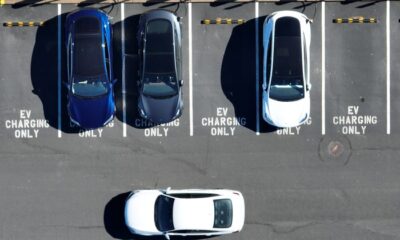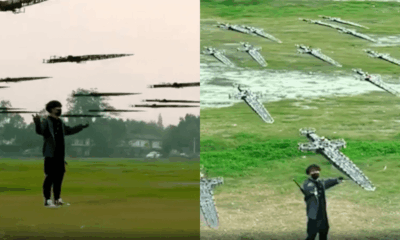Science
Researchers Enhance Tracking Precision for Aerial Defense Systems
In an effort to improve the detection and tracking of low, slow, and small (LSS) aerial moving targets, a team from the National University of Defense Technology in China has developed new methodologies aimed at reducing tracking errors in intelligent electro-optical detection systems (EODS). These systems are critical for defense and security applications, particularly in scenarios where traditional radar fails to provide adequate detection.
The study, titled “Small Tracking Error Correction for Moving Targets of Intelligent Electro-Optical Detection Systems,” was conducted by researchers Cheng Shen, Zhijie Wen, Wenliang Zhu, Dapeng Fan, and Mingyuan Ling. It addresses the challenges posed by small tracking errors that arise from various factors, including limitations in image tracker frame rates, lens resolution, and computing power. Such errors can lead to overshoot and oscillation, making it difficult to maintain the stringent requirement of controlling tracking error to within 1 mrad for precision shooting.
Many existing solutions focus on optimizing individual components like control algorithms or servo mechanisms but often do not integrate these various elements effectively. This can result in slow dynamic responses or inadequate solutions to the multifaceted nature of tracking errors.
To tackle these challenges, the researchers have proposed a comprehensive approach that includes mechatronics drive modeling and composite velocity–image stability control. Their methodology begins with a predictive model for tracking controller delays, employing the Euler transformation model of a two-axis, two-gimbal cantilever beam configuration. This model facilitates a clear understanding of how feedback from the tracking controller interacts with the motor’s velocity-stability loop.
An innovative segmental interpolation filtering algorithm has also been introduced, which combines line of sight (LOS) position correction with multivariable tracking fault diagnosis. This algorithm effectively compensates for time delays caused by non-uniform discrete sampling from the image tracker, enhancing overall tracking performance.
Testing was carried out on a 2-degree-of-freedom platform, simulating an LSS moving target positioned 100 meters away, with a target board area of 1 m² and a linear velocity of 5 m/s. The results were promising: the optimized method achieved a tracking error distribution probability of 66.7% within a 1 mrad radius, significantly outperforming the traditional method’s 41.6% probability. Additionally, the LOS shooting accuracy improved by 37.6%, greatly mitigating the negative impacts of tracking errors.
The full text of the paper, titled “Small Tracking Error Correction for Moving Targets of Intelligent Electro-Optical Detection Systems,” can be accessed at https://doi.org/10.1007/s11465-024-0782-6. This research represents a significant advancement in enhancing the precision and effectiveness of modern defense systems in tracking challenging aerial targets.
-

 Technology5 months ago
Technology5 months agoDiscover the Top 10 Calorie Counting Apps of 2025
-

 Technology2 weeks ago
Technology2 weeks agoOpenAI to Implement Age Verification for ChatGPT by December 2025
-

 Health3 months ago
Health3 months agoBella Hadid Shares Health Update After Treatment for Lyme Disease
-

 Health3 months ago
Health3 months agoAnalysts Project Stronger Growth for Apple’s iPhone 17 Lineup
-

 Health3 months ago
Health3 months agoErin Bates Shares Recovery Update Following Sepsis Complications
-

 Technology5 months ago
Technology5 months agoDiscover How to Reverse Image Search Using ChatGPT Effortlessly
-

 Technology3 months ago
Technology3 months agoElectric Moto Influencer Surronster Arrested in Tijuana
-

 Technology2 months ago
Technology2 months agoDiscover 2025’s Top GPUs for Exceptional 4K Gaming Performance
-

 Technology5 months ago
Technology5 months agoMeta Initiates $60B AI Data Center Expansion, Starting in Ohio
-

 Technology5 months ago
Technology5 months agoRecovering a Suspended TikTok Account: A Step-by-Step Guide
-

 Health5 months ago
Health5 months agoTested: Rab Firewall Mountain Jacket Survives Harsh Conditions
-

 Lifestyle5 months ago
Lifestyle5 months agoBelton Family Reunites After Daughter Survives Hill Country Floods





















